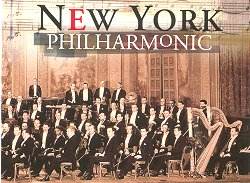NYPO (1923)Founded in 1842, the New York Philharmonic has a legacy no British orchestra can begin to match and it says a great deal when in the space of two glass cabinets you can see scores with alterations made in Mahler's own hand as well as a first edition of Beethoven's Fifth Symphony. And to have both Toscanini's and Bernstein's batons are treasure indeed. You can almost scent the greatness.
No orchestra (including the Vienna Philharmonic) has such a wonderfully tangible relationship with Gustav Mahler and it is fitting that the most cherishable exhibits are linked with this great composer-conductor - and let us not forget that in the early 1900s he was probably the word's most sought after conductor. Mahler's score for the First Symphony (given its American premier in 1909), has all of Mahler's changes registered in red ink. At Tempo Nicht Breiter als Vorber he has changed the dynamic markings of p or pf to ff and made some significant changes to the flute and oboe lines. Bernstein and Bruno Walter have added their own markings in blue. On the front page of the score of Beethoven's Seventh Symphony Mahler has made his own markings (1910), only for Toscanini to add in 1930 a little comment - 'unworthy of such a musician'. As if this has become a scribbling pad, an anonymous writer has added the Latin legend 'nomina stultorum sunt ubique locurum' - 'the words of fools appear everywhere'.
The New York Philharmonic has given many important premiers in its time, but its first, and most important one, was probably that of Dvorak's New World Symphony in 1893 under Anton Seidl. Again, we have the original score, and just as fascinating, the original programme notes. Before the performance of the symphony we had Mendelssohn's A Midsummer Night's Dream and Brahm's Violin Concerto (with Henri Marteau). Tickets were priced from 0.75 cents to a full $2.00!
Letters figure quite prominently in this small exhibition. Amongst the most amusing is one from Leopold Stokowski to the orchestra's manager, Bruno Zirato. Dated 1949, he requests permission to perform Mahler's Symphony of a Thousand - '8000 seats' - but his opening line is just pure Stokowski - 'Just arrived in wicked Hollywood!' (the exclamation mark is daubed in purple paint). A letter from Bernstein to a disgruntled audience member, although from 1966, could so easily be from yesterday.
"It is the duty of any Symphony Orchestra - particularly that of a cultural capital like New York - to keep its audiences abreast of the main currents and developments in 20th century music. The truth of the matter is that the New York Philharmonic does not go far enough in this obligation out of consideration for its large subscription audiences. If the Webern Symphony, already some forty years old, already a classic, and a mere 8 minutes in length, cannot be comfortably absorbed in a season of more conventional music, then I am at a loss to answer."
Pierre Boulez can have his witty moments, as well. In a letter from 1972, he responds to a female correspondent wondering about the dearth of great women conductors and composers. Whilst agreeing that there is probably no physiognomical reason he ends simply by stating, 'my explanation would be, finally, a lack of explanation'.
We can add to this Bernstein's score of Mahler's Sixth with its vast bumper sticker tattooed across the blank opening bars - 'Mahler Grooves' - and his score of the Ninth, on which he has written on the final page, eight bars from the symphony's close, a reminder to himself to "Have the courage to remain in 8". Toscanini's heavily altered score of Debussy's La Mer (with perfectly written notation in red for flute, piccolo and clarinet) is equally fascinating.
Some things of course never change. Toscanini's contract for the 1931-32 season stipulates a salary of $110,000 payable in four instalments. I assume this might just be enough to pay for the marvellous Beethoven first edition (dating from 1826) - and used at the orchestra's very first concert under the wonderfully named Urelli Corelli Hill in 1842.
Along with photographs of all of the orchestra's conductors - from Hill to Toscanini to Barbirolli and Mehta - these unique things make this is a wonderful exhibition. With American orchestras so adept at marketing (I think principally of the magical CD sets now being released by not just the New York Philharmonic, but also by the Philadelphia and Chicago Symphony Orchestras) I wonder where our own orchestras are going wrong. Surely the Philharmonia and London Symphony Orchestras could do something similar? This must surely stimulate interest in classical music and the model for this exhibition should be taken up immediately by all of our orchestras. I doubt, of course, they are even aware it is on.
The exhibition runs until Sunday 11 June. The New York Philharmonic under their current Music Director, Kurt Masur, will play Shostakovich's Leningrad Symphony and Mahler's Ninth on Saturday and Sunday respectively.
.gif)
Marc Bridle

 Return to:
Return to: